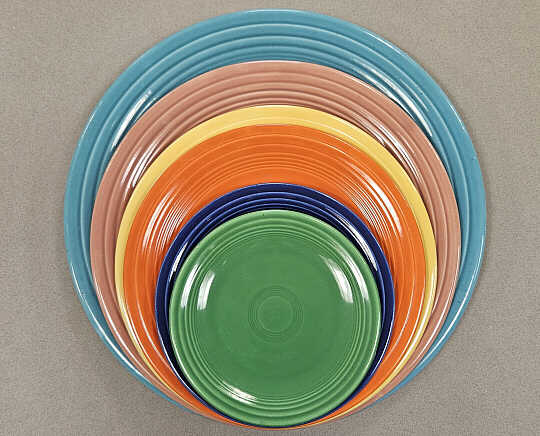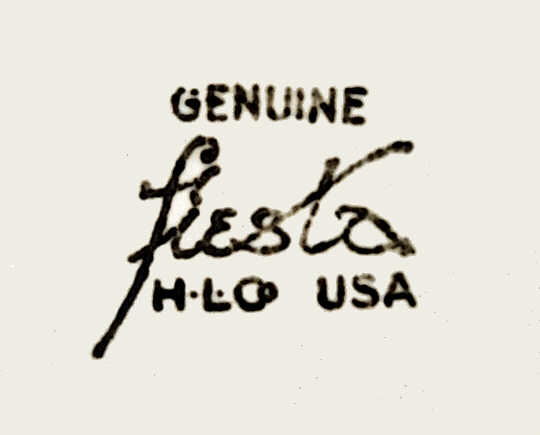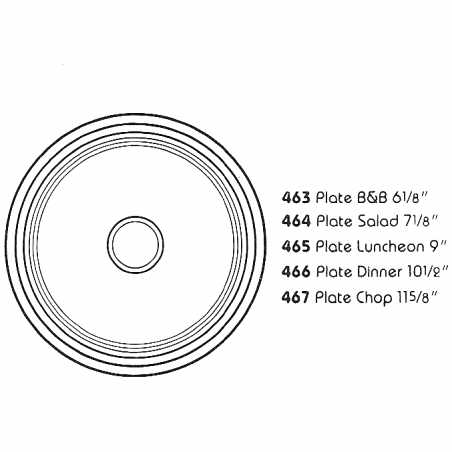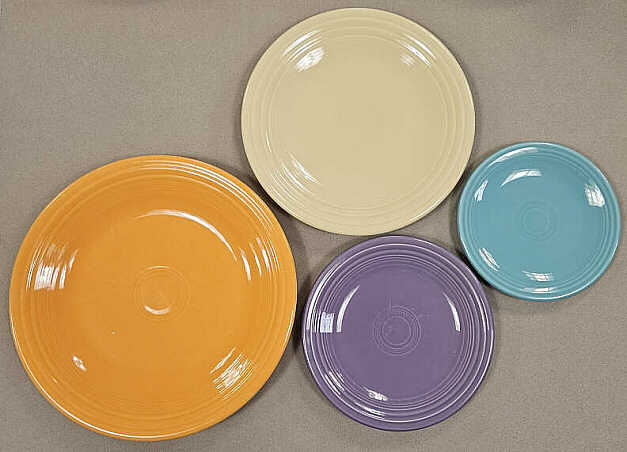|
There were six sizes of Fiesta® plates in the original assortment from January 1936. Their sizes were often listed in price lists as 15", 13", 10", 9", 7" and 6", but their actual dimensions are closer to 14 ⅛", 12 ⅛", 10 ¼". 9 ⅜", 7 ⅜", and 6 ⅜". You may find the actual measurements may vary slightly from one piece to the next. Most were marked with an underglaze Fiesta® backstamp.
The 13", 10", 9", 7", and 6" plates were made until 1969 and can be found in all eleven glazes: red, old ivory, blue, light green, yellow, turquoise, forest green, chartreuse, rose, gray, and medium green.
The 15" chop plate was discontinued before 1959 and can be found in the first ten colors (no medium green).
See also sections on Amberstone/Casualstone and Fiesta® Ironstone.

Drawings of the six sizes of vintage Fiesta® plates from a 1936 price list |

Vintage Fiesta® plates |

Vintage Fiesta® underglaze backstamp |
When Fiesta® was re-introduced in 1986, three sizes of plates were part of the assortment: The 11 ⅝" chop plate, the 10 ½" dinner plate, and the 7 ⅛" salad plate. Soon after, the 9" luncheon and 6 ⅛" plates were added.
The 15" chop plate is the only size that has not been re-introduced.
In recent years, the factory has started calling plates based on the vintage line "classic rim plates" to differentiate from other styles of plates, namely the bistro plates.

Listing of classic rim plates with item numbers from 1989 |

Classic rim plates in tangerine, ivory, lilac, and turquoise |
There have been six distinct Fiesta® bacsktamps used since the reintroduction in 1986. They are described and shown below. For an explanation of the date codes, go to the bottom of this page.
- Fiesta® underglaze backstamp. The vintage stamp was in all lower case, however, backstamps from 1986 to the present have Fiesta® in all upper case.
NOTE: Using the lower case vs. upper case letters rule to date Fiesta® works with the backstamps ONLY. This rule is not always true for mold marks.
- Around 1992, "Lead Free" was added to the backstamp and placed at the top. Also, TM was used after the Fiesta® name to note it was a registered trademark. The TM was replaced in the next mark with an R in a circle.
- In 1993, "Lead Free Glaze" was put at the bottom of the stamp, and the mark was given a circular configuration.
- Later in 1993, the word "Glaze" was removed. This mark was used until the firm was reorganized into the Fiesta® Tableware Company.
- The Fiesta® USA, Lead Free marking was first used in 2020
- The most current marking has Lead Safe. (Technically, there is a seventh marking that falls between the Lead Free and Lead Safe versions. It has Fiesta® USA and the date code, but makes no mention of lead.)
|